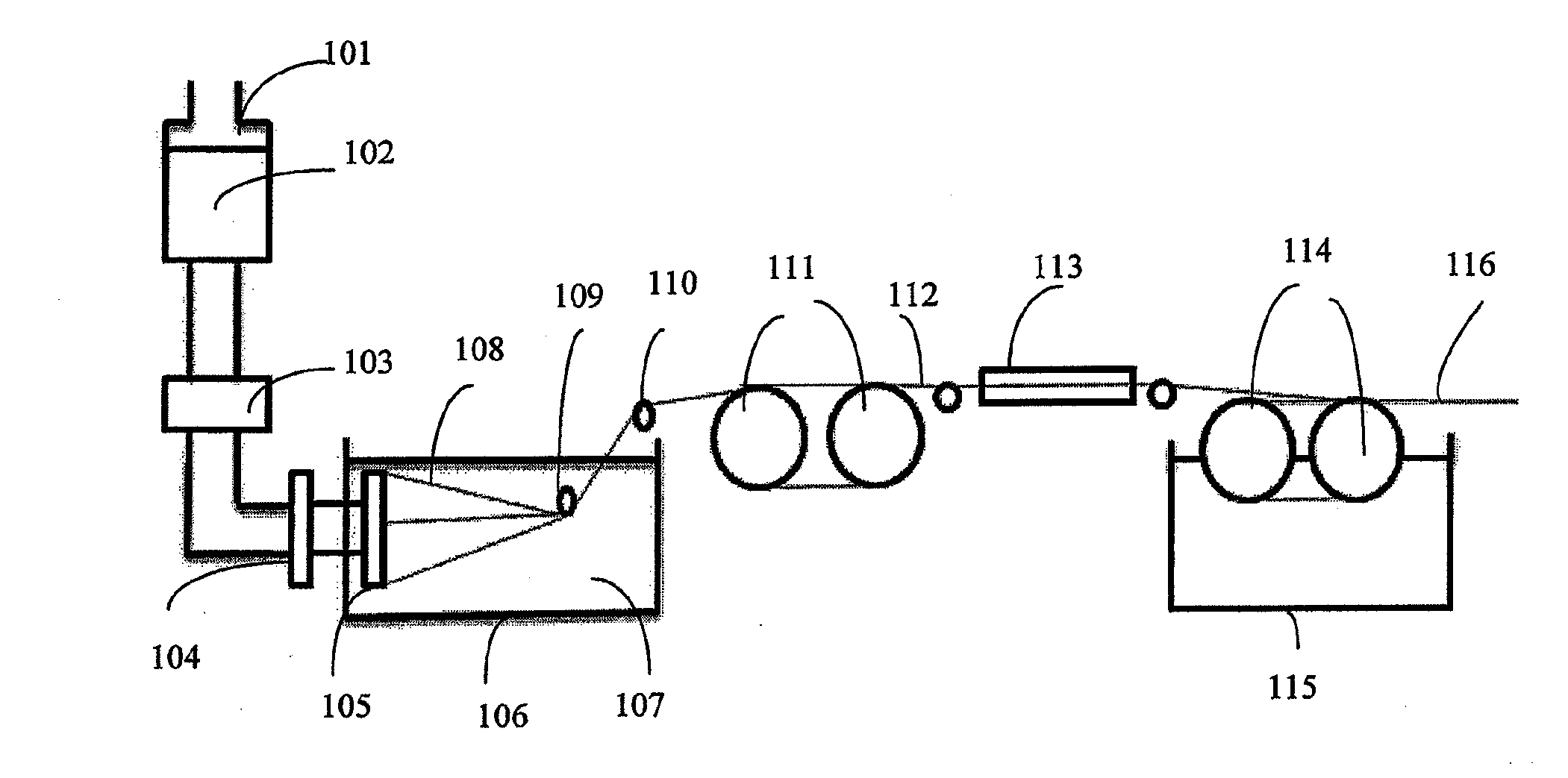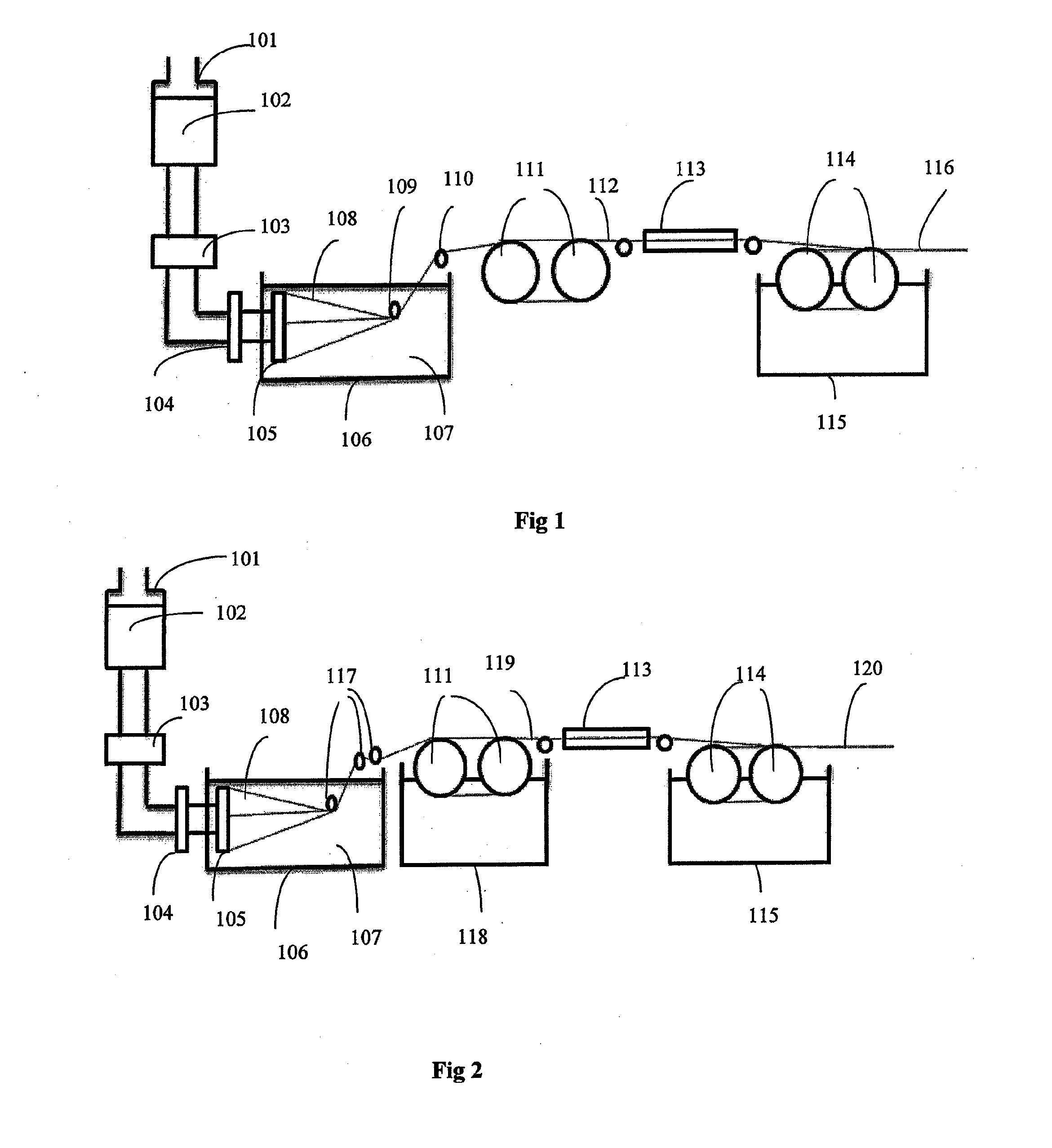Method of producing a swellable polymer fibre
a polymer fibre and swelling technology, applied in the chemical characteristics of fibres, textiles and papermaking, domestic applications, etc., can solve the problems of oxidative stress, inability to absorb water, so as to increase hydrogen bonding and solubility, and reduce the effect of toxicity
- Summary
- Abstract
- Description
- Claims
- Application Information
AI Technical Summary
Benefits of technology
Problems solved by technology
Method used
Image
Examples
example 1
[0073]Calcium alginate polymer fibres containing 1,2-propanediol were produced using the method described with reference to FIG. 1. A 1500 g dope solution was prepared using 5% (w / w) High G sodium alginate (Protanal LF 10 / 60 FT) and 10% (w / w) propylene glycol, PG (supplied by Sigma-Aldrich, by 187° C. density 1.036 g / cm3) The alginate used was supplied by FMC Biopolymer (UK) Ltd) and had the following characteristics: guluronic acid content 60-70%; mannuronic acid content 30-40%; G / M ratio 1.5-2.33, viscosity (1%) 30-60 cps, moisture<15% and pH 6-8. The required amount of the alginate powder (75 g) was first dissolved in 1275 g of water for 30 minutes using a Greaves high shear mixer. Then, 150 g of PG was slowly added and further stirred for 30 minutes or until fully mixed and homogeneous dope. (viscosity 8,000-10,000 cps at 26° C. using Brookfield Digital viscometer (RVTD), spindle No. 04). The solution was slowly fully vacuum de-aerated, spun through a cartridge filter (25-micron...
example 2
[0074]Calcium alginate and psyllium polymer fibres containing 1,2-propanediol were produced using the method described with reference to FIG. 1.
[0075]A spinning solution (6,000 g) was prepared comprising 240 g (4% w / w) High M sodium alginate, 45 g (0.75% w / w) psyllium husks (Plantago ovate, supplied by W. Ratje Froeskaller ApS Husk Products, Kirstinehoej 34, DK-2770 Kastrup, Denmark) and 120 g (2% w / w) PG. The high M alginate (Manucol DH) was supplied by FMC Biopolymer (UK) Ltd) and had the following characteristics: mannuronic acid content 60-70%; guluronic acid content 30-40%; G / M ratio 0.43-0.67, viscosity (1%) 40-90 cps, moisture <13% and pH (1% solution) 5.0-7.5.
[0076]First, the psyllium was soaked in about 5,600 g of water for 1 hour at room temperature and at the end filtered through a Philips blender cartridge filter. The filtered aqueous psyllium solution was then stirred vigorously using a high shear mixer whilst gradually adding the alginate powder. The alginate was allow...
example 3
[0077]Calcium alginate and psyllium polymer fibres containing 1,2-propanediol and antimicrobial silver ions were prepared using the method described with reference to FIG. 1.
[0078]Example 2 was repeated except that the dope contained 3 g (0.05% w / w) silver carbonate. The silver carbonate can be dispersed in water by sonicating for 1 hour in ultrasonic bath before mixing into the filtered psyllium solution. However, in this example, the carbonate was dispersed in PG, sonicated briefly (10 minutes) before adding to the dope. After deaeration and filtration, the dope was spun through a 90μ / 2000-hole spinneret.
PUM
| Property | Measurement | Unit |
|---|---|---|
| Percent by mass | aaaaa | aaaaa |
| Concentration | aaaaa | aaaaa |
| Water solubility | aaaaa | aaaaa |
Abstract
Description
Claims
Application Information
 Login to View More
Login to View More - R&D
- Intellectual Property
- Life Sciences
- Materials
- Tech Scout
- Unparalleled Data Quality
- Higher Quality Content
- 60% Fewer Hallucinations
Browse by: Latest US Patents, China's latest patents, Technical Efficacy Thesaurus, Application Domain, Technology Topic, Popular Technical Reports.
© 2025 PatSnap. All rights reserved.Legal|Privacy policy|Modern Slavery Act Transparency Statement|Sitemap|About US| Contact US: help@patsnap.com


